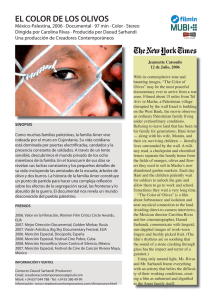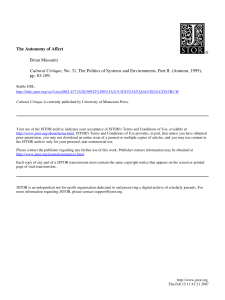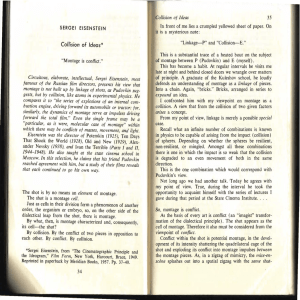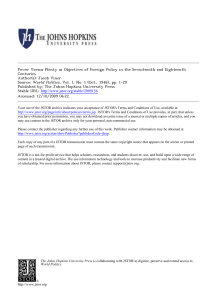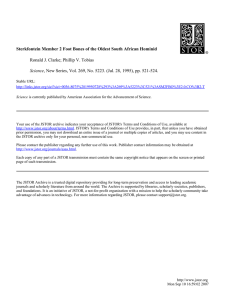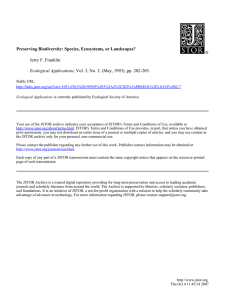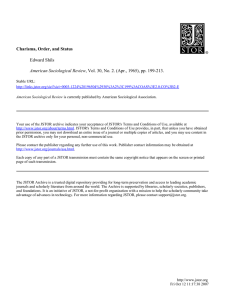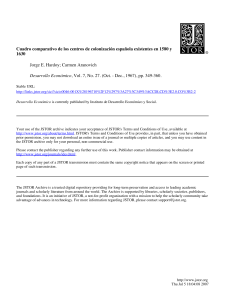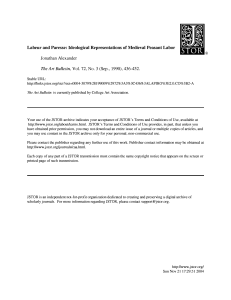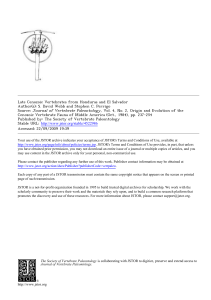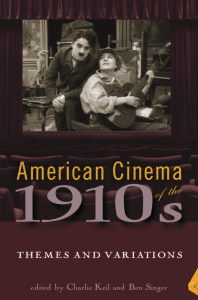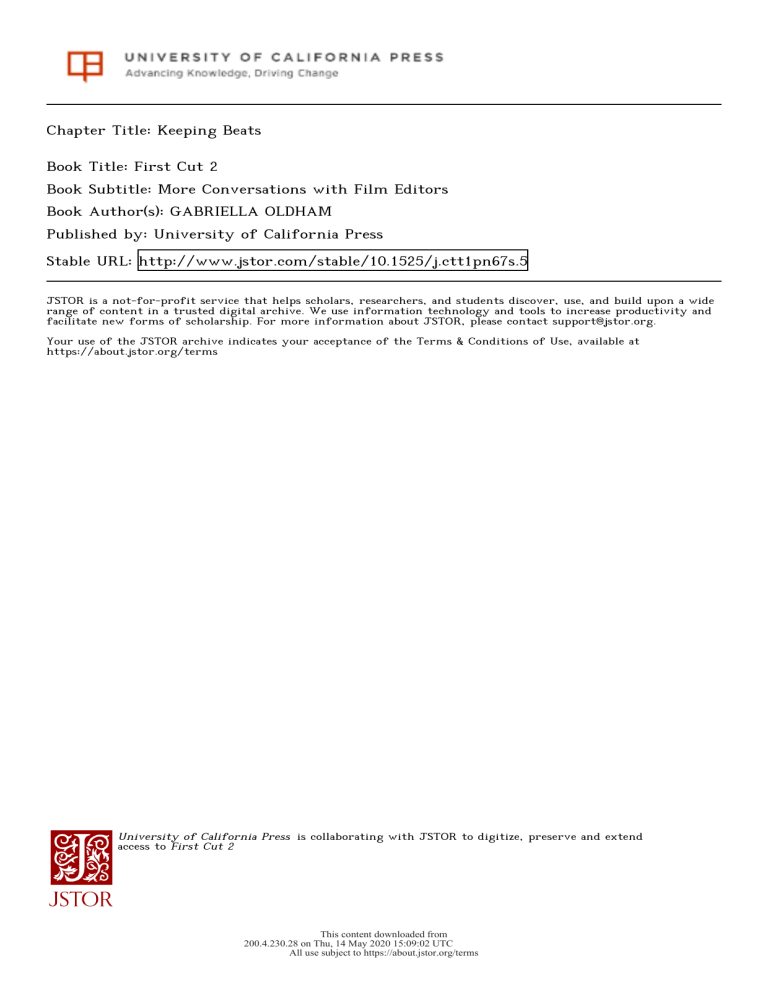
Chapter Title: Keeping Beats Book Title: First Cut 2 Book Subtitle: More Conversations with Film Editors Book Author(s): GABRIELLA OLDHAM Published by: University of California Press Stable URL: http://www.jstor.com/stable/10.1525/j.ctt1pn67s.5 JSTOR is a not-for-profit service that helps scholars, researchers, and students discover, use, and build upon a wide range of content in a trusted digital archive. We use information technology and tools to increase productivity and facilitate new forms of scholarship. For more information about JSTOR, please contact [email protected]. Your use of the JSTOR archive indicates your acceptance of the Terms & Conditions of Use, available at https://about.jstor.org/terms University of California Press is collaborating with JSTOR to digitize, preserve and extend access to First Cut 2 This content downloaded from 200.4.230.28 on Thu, 14 May 2020 15:09:02 UTC All use subject to https://about.jstor.org/terms 1. Keeping Beats MARK LIVOLSI 2001 Vanilla Sky (coeditor), dir. Cameron Crowe 2003 Pieces of April, dir. Peter Hedges 2004 The Girl Next Door, dir. Luke Greenfield 2005 My Suicidal Sweetheart, dir. Michael Parness 2005 Wedding Crashers, dir. David Dobkin 2006 The Devil Wears Prada, dir. David Frankel 2007 Fred Claus, dir. David Dobkin 2008 Marley and Me, dir. David Frankel 2009 The Blind Side, dir. John Lee Hancock 2011 The Big Year, dir. David Frankel 2011 We Bought a Zoo, dir. Cameron Crowe AWARDS 2006 Eddie Award (ACE) nomination, Best Edited Feature Film— Comedy or Musical, Wedding Crashers 2007 Eddie Award (ACE) nomination, Best Edited Feature Film— Comedy or Musical, The Devil Wears Prada With a computer screen glowing off to the side of his New York cutting room, Mark Livolsi spoke of some of the box office smashes he has edited, including Wedding Crashers, The Devil Wears Prada, and Marley and Me. Livolsi peppers his comments with some essential metaphors (playing jazz, handing off batons, making a stew) that many editors here, as well as in the first volume of First Cut, have evoked in discussing their art and 13 This content downloaded from 200.4.230.28 on Thu, 14 May 2020 15:09:02 UTC All use subject to https://about.jstor.org/terms 14 / MARK LIVOLSI craft, establishing the multilayered nature of being an editor. In addition to metaphors, Livolsi offers practical illustrations of the many day-to-day decisions and pressures that an editor in the twenty-first-century cutting room faces, including the need to work faster because of tight schedules, excessive amounts of dailies, and “infinite” possible edits that the new technology facilitates. As Livolsi also notes, technology has finally eliminated the physical tedium of splicing film and the clatter of sound cuts that were prominent in editing on celluloid. However, the fundamental principles of editing—to find the story, tap into emotional truth, and present the material for maximum impact—remain key editorial responsibilities, as they have since the beginning of narrative cinema. Because many of Livolsi’s films to date have been comedies, he offers a strong analysis of the editorial necessities of that genre, but he has also been extending himself beyond comedy to explore other types of film. Cutting across all genres, however, is perhaps editing’s greatest challenge: discovering the “story” and its related concerns with pacing and rhythm. Livolsi reflects enthusiastically on how actors’ improvisations, special effects, and the occasional “crane shot” can impact his efforts to pull the most effective story out of the chaos of feature filmmaking. When did you start editing? I started when I was a kid. My father had an 8mm camera and shot home movies and I was fascinated by them. One day I found his camera in the closet, and I bought film and started to shoot. It slowly occurred to me that movies—which I loved—were something I could make as well. I started with little zombie movies. Back in the seventies, I was obsessed with George Romero and Night of the Living Dead, and zombie movies seemed easy to make. I was also into theatrical makeup, especially scars, so it seemed like the way to go. Just you and your friends? And my brother, Tim. In one film, I had my next-door neighbor attack and eat my brother! I have that movie somewhere in the attic, and my brother still talks about how I forced him into it. (Laughs.) Did you edit in camera? I did, actually. In fact, I remember the moment when I first made an edit in camera. It literally was a shot of my brother walking down the driveway, holding a BB gun, and I shot it in a wide. Then I paused my brother midaction and grabbed a medium shot from another angle. When I got the film This content downloaded from 200.4.230.28 on Thu, 14 May 2020 15:09:02 UTC All use subject to https://about.jstor.org/terms K E E P I N G B E AT S / 1 5 back from the lab and looked at it, here was this professional piece of work! It actually told a little story in two shots and that fascinated me. Did you have any editing equipment at the time? I had a small hand-cranked splicer. My dad used it to cut out all the overexposed bits of film. I used it primarily to watch those old Castle Films, which were eight-minute condensations of my favorite movies. How about scripting? I’d say my movies were done on the fly, although I did write some scripts, but silly ones that were ten, twelve pages long involving massive special effects and alien invasions. I remember showing one script to my art teacher who remarked, “It’s a good script, but I think you bit off more than you can chew!” He was right because I never shot it. The planning, the coordinating, the sheer magnitude of what it took to actually make a film was to me so painstaking and daunting that very few of my epic projects ever left the planning stages. I was beginning to realize that each shot is a setup that has to be lit separately. Before that, I thought you’d just run out there and grab it like in a documentary, right? And then I realized, my God, you mean each of these shots has to be created separately and you have to move the camera here, move it there, set up lights? Forget that! I’ll wait till it’s all in the can and then work with it. Aside from wanting to avoid those filmmaking logistics, why did you gravitate to the editing process itself? I found I had a natural inclination for editing when I was in college. I tried everything at Penn State, which had a wonderful, very small film program. It was amazing because I had the opportunity to use equipment as opposed to competing for it. I learned how to write screenplays, direct actors, record sound, edit . . . but of all the filmmaking crafts, the only one that came easy to me was editing. In fact, with editing, I could get lost for fifteen, sixteen hours in the basement of the film department and just create, you know, put the film together. It was clear to me and it was clear to my girlfriend, Maria (who later became my wife), that editing seemed to be the right direction for me. Did the detailed nature of the work appeal to you? I think there was an obsessive component, a need to make order out of chaos. The chaos of infinite options, of infinite ways of cutting, of infinite This content downloaded from 200.4.230.28 on Thu, 14 May 2020 15:09:02 UTC All use subject to https://about.jstor.org/terms 16 / MARK LIVOLSI performance choices, and what seemed like an infinite amount of dailies and turning it all into one final, decisive piece of storytelling. It was all instinctive. I never sat down and said, “This is what I like.” I just did it and didn’t think twice about it. When I got out of college, I focused on that. I said, “Okay, I’m not going to try to be a director or a writer. I know I’m good at editing and I’m going to get in there.” And that’s what I did from day one. Did the chaos of editing ever overwhelm you? To be honest, in college, you never have an overwhelming amount of footage. You barely have enough footage to tell a coherent story! But certainly in the professional world, there can be an overwhelming amount of footage, and, yes, I have been overwhelmed at times. That’s when you hire second editors to come in and help you out. As much as possible I try to tackle these situations by myself. It becomes a personal contest. But at a certain point, you risk undercutting the project because of your inability to look through all the footage and give it careful attention. I imagine that if you parcel out work to others, you still have to oversee it. Absolutely. It’s my responsibility as the editor. I like to delegate creative work to my assistants, who benefit from the chance to flex creative muscles and hone their abilities. In return, I get the benefit of their opinions and the wider perspective that collaboration brings. But this mostly happens during shooting, before the director walks in the door to begin his director’s cut. From that point on, it’s mostly between the director and myself. Are you partial to editing any particular genre—besides zombie movies? Yeah! No, I love all movies. I started with horror films as a kid, and blossomed into a little bit of everything. I love noirs, Westerns—I was a big holdout against Westerns for a long time, but finally fell under their spell a few years ago. Comedies, especially the classics, Marx Brothers, Buster Keaton. But that’s just as a viewer. As an editor, I think challenges are to be had in any genre, and I would love to work in all genres. My goal is someday to cut a musical, a thriller, a drama— whatever. It’s really immaterial because I think telling a story well is the great challenge of editing, just creating effective storytelling and This content downloaded from 200.4.230.28 on Thu, 14 May 2020 15:09:02 UTC All use subject to https://about.jstor.org/terms K E E P I N G B E AT S / 1 7 doing the best work I can on any film. But it seems like all I’ve done so far is comedies! I was just going to say that. Well, that happens. You do one comedy film, somebody sees it and thinks you did it well, and that leads to another comedy film, and the next thing you know, you’re being stereotyped as a comedy editor. That certainly doesn’t preclude you from being able to do other genres, though. One of the main reasons I recently did The Blind Side was to try my hand at drama. You made an interesting point that each genre poses its own set of challenges. However, since your overarching concern for all films is story, what are different editorial challenges within each genre? Well, the prime directive of comedy is to make people laugh and to tell a story entertainingly. I think, then, that issues of rhythm and pacing in a comedy are different than they would be in a drama or horror film. You certainly have to present the material in a way that achieves maximum impact, but a brisk comedy won’t necessarily have the same presentation as a thriller. By pacing you mean . . . A combination of length of shot, rhythm of cutting, number of cuts, connections. And use of sound and silence? Exactly. The kinetic qualities that are either within the frame or imposed on the film by the editor, by the editing itself. Marley and Me has both comedic and dramatic scenes in it. Can you speak of that film as an example to compare the pacing of each? Marley and Me begins as a comedy and gradually morphs into a drama. The first half of the film is generally briskly paced. We never outstay our welcome in those early scenes. And that, I think, is one of the mandates of editing comedy. People become invested through laughter, through enjoyment of the experience of watching comedy. The minute they become bored or the film loses its focus, you risk losing them and it becomes that much harder to get the momentum back. If a scene wasn’t funny enough or slowed down too much, David Frankel, the director, would toss it out. This cut-and-dry approach was a little more complicated in the later, This content downloaded from 200.4.230.28 on Thu, 14 May 2020 15:09:02 UTC All use subject to https://about.jstor.org/terms 18 / MARK LIVOLSI dramatic scenes. Audience investment wasn’t dictated primarily through pace and laughs, but through investment in the characters and their problems. It was often a hard call to make: is a scene too long or just right? The third act wasn’t terribly plot-driven, each scene being a beat in the declining years in the life of a dog. We went back and forth on the length of many of the later scenes, as well as removing and reordering them. When you say that each scene is a “beat,” are you referring to the action within the scene or the rhythm of how the shots are cut together? A beat is like an ingredient. It could be small, a moment within a scene, or it could be a whole scene when looking at an entire film. When I’m looking at a film overall, I tend to think of it as a sort of stew, and you need many different ingredients. Like you can’t leave out the salt—you need a pinch of salt here, a dash of something else there. Marley and Me is sort of a tone poem, more about emotion than plot. In fact, there’s very little plot. It’s very episodic. So when the plot especially in the second, more dramatic half is not advancing at a breakneck pace, then the film becomes all about the little emotional beats and what adds up to make the best stew. What is the best recipe? Well, you figure that out by trial and error. So for instance, toward the end of Marley and Me, when the dog is very sick, Owen Wilson’s character talks with the dog as they’re walking up a hill, asking Marley to let him know when “it’s your time to go.” The next scene shows Owen finding Marley lying near the fireplace, too old to climb the stairs. We removed this scene, but found that suddenly the next scene, where Marley is dying at the vet, came too soon. We needed the fireplace scene as a bridge to make clear that time had passed, that the scene on the hill and the dying scene weren’t happening one right after the other. That was a necessary beat. So the beat or scene of the dog by the fireplace served to transition between the beat of the sick dog on the hill and the beat of the dying dog at the vet. Yes, it was a transitional point. In a film where we deliberately avoided referencing the passage of time with titles, we needed to show the passage of time in subtler ways. That scene represented a necessary space. In that way, you don’t think it all happened from one day to the next, but you have the opportunity to think it’s more gradual. The beat of that scene also reinforced Owen’s connection to the dog— Which I felt was solid throughout the film. The dynamic was clearly between Owen and the dog. The triangle between Owen, Jennifer Aniston, This content downloaded from 200.4.230.28 on Thu, 14 May 2020 15:09:02 UTC All use subject to https://about.jstor.org/terms K E E P I N G B E AT S / 1 9 and Marley was not a perfect triangle in that sense. A scene that we ultimately took out might have helped to balance the triangle—but maybe not, because it happened too late in the film. It was a scene where Jen has a private moment with Marley under a tree. It would have been interesting, but again for pacing reasons, we were cognizant that we had to honor the progress of the dog’s decline and death, while also being aware of not overly methodically pacing it by including every beat we had. Also, when we previewed the movie, some of the audience commented that the film was too sad for too long. Some things had to fall by the wayside. But the ending had to be sad. Moreover, it was a true story. Yes, it was based on John Grogan’s book. Many people commented on how obvious or manipulative or whatever it was to kill off the dog at the end. Never mind that it actually happened! Still, because the first half of the film was so bouncy and comedic, and the second half depicted such a sad reality, the film almost splits in two. I do feel that the transformation is gradual, though. Yes, it is a very different film in the first act than it is in the third act, and juxtaposed side by side, they seem black and white. But the second act I consider a baton handoff, so that the film morphs into more serious material. In the beginning, it’s all very cute and sparkling and hilarious. Then it starts to become serious in the second act, dealing with real issues such as when Jen has a miscarriage and she and Owen fight a lot, but there are still comedic moments. By the third act, I can safely say there is no comedy. Now, Wedding Crashers has the same sort of paradigm, although not as extreme, where we start out as a crazy-guys comedy and then suddenly it’s more serious, or at least more like a romantic comedy, with the emphasis on romantic. Again, there’s a baton handoff that I find interesting, with the comedy between Vince Vaughn and Owen Wilson turning into Owen’s more serious romantic story. I remember when we got to the postprocess on that film, a twenty-something-year-old guy working at a video facility was watching the movie as he was turning out reels. He was laughing his head off at the beginning, and then about halfway or two-thirds through, he looked up and said, “Hey! This is a chick flick!” He was completely confused. It snuck up on him that the movie was suddenly trying to be something else. In the opening montage to the song “Shout!” when Vince and Owen are crashing several weddings and picking up girl after girl after girl, you This content downloaded from 200.4.230.28 on Thu, 14 May 2020 15:09:02 UTC All use subject to https://about.jstor.org/terms 20 / MARK LIVOLSI sense Owen is unhappy by the end of it. It was almost foreshadowing that Owen was facing a major life change, unlike his buddy Vince. That’s right. I think any film that doesn’t really “feather in” those sorts of turns is the poorer for it. In Wedding Crashers, I noticed another comedy-genre device not seen much anymore—wipes! Yes, wipes can live in a comedy environment because they’re whimsical, like a page turning. They’re punctuation marks, so to speak. A dissolve usually means “later on, that same day.” A fade-up and -out could be “later on, that same year.” A wipe is “meanwhile, in the next room,” or some such. In Wedding Crashers, since parallel stories were going on a lot, especially when Vince was trying to win over Isla Fisher and Owen was in a parallel circumstance trying to win over Rachel McAdams, I saw opportunities to wipe from one to the other. I had absolutely no predisposition to use wipes. In fact, I usually try to avoid that sort of thing. But the footage guided me and, in this case, wipes seemed best. Not to stereotype you further, but I notice that montages seem to be something of a trademark for you. Wedding Crashers, Marley and Me, and The Devil Wears Prada all had them. I know. They get thrust upon me! (Laughs.) They’re in the script, of course. The Blind Side had two of them practically back-to-back. Montage has been the cornerstone of editing, from the days of Sergei Eisenstein. What are the purposes of your montages here? To enhance comedy? Compress time? Tell visual stories? Substitute for long dialogues? The answer is “all of the above.” I can think right off to the “James Holt sequence” in The Devil Wears Prada, where Miranda Priestly, the Meryl Streep character, goes to the James Holt showroom to view the latest fashion and disapproves of everything she sees. The dailies rolled in and I spent the better part of that day cutting that scene. It was clearly going to be way too long if it played in real time. At one point, I got up to clear my head and said, “This just has to be montaged.” I thought I was being brilliant till I reread the script pages, which described the scene as a series of quick cuts—something I had missed the first time around. So much for brilliant! But the lesson is still there: creating the impression of something is oftentimes much more satisfying than sitting through the real thing. So in that case, a montage was an expediency. The whole point of that scene was that there is a fashion presentation and Miranda is This content downloaded from 200.4.230.28 on Thu, 14 May 2020 15:09:02 UTC All use subject to https://about.jstor.org/terms K E E P I N G B E AT S / 2 1 unhappy with it. It was a no-brainer then to take all those shots and do what montages tend to do, which is distill an idea into its purest essence and make it move as fast and entertainingly as possible. Montages can be strategically placed to provide a jolt of energy at a certain point when you feel you need it. A montage in Marley and Me takes place at the end of the first act, with shots of the dog’s antics set against music, and it was specifically placed to propel you into the second act as well as convey the passage of time. And the opening montage of Wedding Crashers was obviously trying to reduce the concept of many weeks, many weddings, many girls, many experiences into one single entertaining, organic entity. In itself, it told a little story of the guys’ lifestyles, too. Yes, it told a whole story with its own arc and provided enough energy and sex and good will to keep you going through the next part of the film, which was the inevitable setup for the story itself. In fact, the next scene after the montage is a quiet dialogue scene, so hopefully the residual energy from the montage carries you through that scene to the next one and beyond. I have to say that the Wedding Crashers montage was such high energy I was almost palpitating by the end of it! (Laughs.) Thank you! Yet nothing like that reappears in the film, which slows down, by contrast, almost to the point of somberness. Is it a risk to create such energy so early in a film and not revive it later? It would have to be considered on a case-by-case basis. In that situation, the idea was that people wanted to see Vince and Owen as wedding crashers—it is the name of the film, after all. Let’s get all the crashing out of the way so we can have the story we want to tell, which ultimately became a romantic comedy—again, emphasis on romantic. Actually, there is another montage later on that I call the “sad-Owen montage,” when he’s lost everything important in his life. It’s a visual storytelling device for passage of time. It’s there for a very specific reason: to show him bottoming out. And to go back to your question of beats, each shot in that sequence or montage is a beat. We structured the “sad-Owen montage” so that each beat felt like it was in the right place for his descent, lower and lower. Some beats were stronger with a little comedy; other beats emphasized his character’s sadness. Feathered within that was a parallel story—Rachel McAdams’s growing uncertainty over her future. Ultimately, each beat This content downloaded from 200.4.230.28 on Thu, 14 May 2020 15:09:02 UTC All use subject to https://about.jstor.org/terms 22 / MARK LIVOLSI was juxtaposed to show these two people going on separate minijourneys— Owen disintegrating and Rachel questioning. This transitional montage sets these characters up for their decisions in act three. When you say you structure a montage to accomplish x, y, and z, do you mean literally mapping it out shot by shot on paper or just in conversation with the director? And how long does it take you to cut a montage like that? It varies. Cutting the wedding-crashing montage was done in bits and pieces and fits and starts throughout the shooting process because the crew would pick up little pieces of weddings when they could. It wasn’t like all the film for that came in over a one- or two- or three-day period and suddenly that was my next scene to cut. The opening “Shout!” montage was scripted as such, and the director, David Dobkin, had a very specific idea for it. We used the Isley Brothers version of “Shout!” where the song would slow down and then pick up again. David wanted to see that musical breakdown translated into a montage. Side by side, he and I built the montage. We would cut the music together to achieve that sort of shape and then start to put pieces in. We would go through the footage, David would find pieces he responded to, and then sometimes he would leave the room and I would do the roll-up-your-sleeves work and give it its visual rhythm. Sometimes at the end of a day, when I was tired of working on a regular scene, I would play around with the montage. It’s very important when you work on a montage to stay fresh, and for me, it works best to spend an hour here, an hour there, maybe devoting a whole Saturday to it, scheduling it outside everything else. I think that is key for editing in general—to keep it fresh, go back to it at different times. You can develop a tendency to work a scene to death and obsess over a cut. I mean obsess for hours over a cut. Editors have often mentioned that tendency. Here’s an example from Wedding Crashers. Rachel McAdams is sitting on a sailboat. She gets up to join Owen, so I needed to—I mean, I obsessed about cutting from a close-up of her to a wide shot as she stands to walk across the sailboat. I just couldn’t get it right. I spent hours. Then I got it to a point where I could live with it. I didn’t love it, but I could live with it. What was wrong? It just wasn’t a perfect match. Rachel was not in the same position in both shots, so finding that key point where you could get away with This content downloaded from 200.4.230.28 on Thu, 14 May 2020 15:09:02 UTC All use subject to https://about.jstor.org/terms K E E P I N G B E AT S / 2 3 it was eluding me completely. I reached the moment where I thought I could live with it. Then a few days later, I went back to the scene and realized it didn’t matter how good or bad the match was. It took too long for her to move, so I just took out the whole middle and had her spring up instead. And you know what? It looked fine! It didn’t match exactly, but you don’t notice it in real time, and it achieved a greater good—better pacing. So coming to it fresh is really important. I know a lot of editors who will cut a scene and put it away immediately, then revisit it the next morning and see something that wasn’t apparent before. Do you feel the need to break with principles of matching that are fundamental to “good editing” and jump cut instead wherever it makes sense? In editing and working with dailies, you juggle so many balls at one time. You deal with rudimentary issues like matching an actor’s movements or performance, or the overall direction of the scene, or the placement of shots into a scene, or the position of a scene in the context of a film. You have to continue thinking about the whole, though. So in the “Shout!” montage, with hundreds of jump cuts from closeup to long shot and everything in between, what principle guides cutting those shots together? Can you achieve seamlessness by jump cutting? Yes, in that you’re matching motion. You’re not matching reality, you’re matching energy, and that’s my consideration. When I cut a montage like the “Shout!” one in Wedding Crashers, I tend to defocus my eyes, watch the overall motion of what’s going on, and feel my way through the montage. I defocus my brain in a way and edit from a place in the back of my brain. It’s instinct, but then again not entirely, because when you’re juggling all those balls, you’re dealing with some very frontof-brain stuff—story, dialogue, and so on. However, in editing, you are also dealing with much that comes only from a gut place and a rhythmic place, so in cutting something like a montage, I go into a bit of a trance state. That’s the best way to describe it. I guess I’m not alone in approaching it that way. You end up feeling and can’t necessarily intellectualize about it. It’s a process of trial and error. Is the shot too short? Too long? Should it be two shots earlier? Or three shots later? If it’s a shot where you’re trying to match movement or create a general pattern through This content downloaded from 200.4.230.28 on Thu, 14 May 2020 15:09:02 UTC All use subject to https://about.jstor.org/terms 24 / MARK LIVOLSI energy, you can sometimes tell where the shots should be, but it still boils down to playing with it, trial and error. In other words, you can achieve a working trance, but something that isn’t “right” in the film can jolt you out of it. It could jolt you out of the trance and you either make a mental note as you’re watching or you stop dead right there to fix it. In my own process, I prefer to smooth the wrinkles out on the bed as I go along, so to speak. When I’m watching a scene back for the first time—not necessarily a montage, but any scene—the moment I hit something that seems wrong, I’ll stop and fix it. Then two seconds later, there might be something else wrong and I’ll start from the beginning again and fix it until I’ve completely smoothed the bed sheet and taken it all the way down and it’s perfect for me. If that’s ever possible! Does music help you to make bits and pieces come together in a montage? Definitely. As I said, the “Shout!” montage was scripted to use that song. The opening montage in The Devil Wears Prada was a different situation. We initially didn’t have a song in mind. The point of that montage was to show the world of high fashion opening up, and bring it back to Anne Hathaway’s plain character through comparing and contrasting images. Yes, that montage is full of quick-change surprises. For example, Hathaway’s character puts on a plain shoe, then her shoe cuts to a fashionable high heel, which belongs to a glamorous model we didn’t expect to see, and so on. That was the overall idea. Once I found the right piece of music for it, the montage came together really fast. Initially, again, the film pieces would come in scattershot over three months of shooting, and if I found two or three shots that could go together, I would make a tiny sequence of them and store them in a bin in the Avid. Then I’d come back to it bit by bit. One day, I realized I had to face this thing and finally put it together because I seemed to have all the pieces I needed. When I’m putting together my first cut of a film, I need to add music, whether it’s temp score or songs, and everyone gets to participate in the search process. My assistants and I initially look for music, along with the help of a music supervisor, and finally a music editor. In the case of Prada’s opening title montage, one of my assistants, Amanda Pollack, happened upon KT Tunstall’s song “Suddenly I See,” which was at that point brand new and relatively This content downloaded from 200.4.230.28 on Thu, 14 May 2020 15:09:02 UTC All use subject to https://about.jstor.org/terms K E E P I N G B E AT S / 2 5 obscure. As soon as I heard it, I knew it was perfect for the scene. It worked so well with the images that the scene pretty much flew together in a few hours—it was a pleasure to cut. How do you handle music on a sequence that isn’t meant to be a montage but rather a straight performance? My instinct is to use restraint as much as possible in dramatic scenes because they can become very maudlin with music. The Blind Side, for example, could have gone over the edge and off the cliff if the music wasn’t restrained. The plot was dramatically ripe enough as it was, and if the music was too emotional, it would have been manipulative in a bad way. John Lee Hancock, the director, and I were very aware of this fine line, and in defining the tonality of the score, we’d occasionally find that no music worked best of all. The scene where Sandra Bullock’s character, Leigh Anne Tuohy, gives Michael Oher (played by Quinton Aaron) a bed for the first time was clearly a place to avoid music and allow the actors and the charged moment to carry the scene. Overall, the power of music can help me as the editor understand a scene and begin to see the finished product in my mind’s eye. But, bottom line, I don’t want to create emotion with the music as much as I want to underscore and uphold the emotion that hopefully is already in the footage. Speaking of withholding music, another film you edited, Pieces of April, has hardly any music in it at all. Yes, and it was always intended to be music-free, with the exception of the ending, because the emotional release of the film was to occur at the very end of the film, when the mother and daughter characters reunite for the first time. That release was to be underscored by the music which, again, reinforces what I was just saying. That is a sort of textbook-y case of music used in an extreme way—withholding, withholding, withholding, allowing the film to build up dramatically without music, then letting go at the very end with music full force. That was the original intention, although after I was off the film and on to other projects, the director, Peter Hedges, decided to put snippets of score throughout the film in small transitional scenes. It was just enough to allow the music at the very end to feel organic to the film and not a complete left turn for the audience. Again, it’s a question of feathering elements into a film. The music is feathered in enough so that it becomes part of that film’s world and doesn’t come out of nowhere at the very end. It seemed like the right choice for a film that had an “indie” feel. It was shot for very little money on video This content downloaded from 200.4.230.28 on Thu, 14 May 2020 15:09:02 UTC All use subject to https://about.jstor.org/terms 26 / MARK LIVOLSI in like two weeks with a purposely gritty, vérité style. I think it just proves that you don’t have to have a polished style to tell a story effectively if the screenplay, characters, and acting are all good. Thanks for the lead-in to talking about a polar-opposite film like Fred Claus. How did those high-budget computer-generated special effects affect your editing process? They affected my whole life! (Laughs.) It’s such a huge undertaking to work on a film like that. In some ways, you have to be more proactive, with an eye toward the finish line. You need to fine-tune cut scenes much earlier so that you can turn them over for visual effects, which can take a long time to generate. One of the primary reasons I took on that film was because I wanted the challenge of trying something new. To tie back to the earlier question about different genres, I always welcome working on different types of films. I never want to do the same thing twice if I can help it. Even though Fred Claus was another comedy? (Laughs.) Yes, it was another comedy, but there was a new angle to it—big special effects. That aspect of that film attracted me primarily. Plus it was a Christmas film and I’m kind of a Christmas guy, so I wanted to play in that sandbox for a while. Describe what you actually got to cut since so many special effects were added in after the editing. Well, the effects were feathered in during the process. We’re given temp versions of visual effects to pop into the film at various points in postproduction. The film kind of evolves. Individual shots, the building blocks for any scene, need to exist in some form. Whether it’s a previsualization or storyboard or actors standing in front of a green screen, you need something to convey the idea of a scene. Does having a green screen in the images throw off your editing judgment? No, it really doesn’t. It’s surprising to me how easily I adapted to that style of filmmaking. I was able to look past all that. However, one thing I can’t look past is bad sound. Most often, fortunately, the sound is workable, but shooting on locations like a beach or near a highway can make the tracks very hard to smooth out. If I hear bad audio edits or obvious tone shifts, my rhythm is thrown off. So I have to try to cross-dissolve This content downloaded from 200.4.230.28 on Thu, 14 May 2020 15:09:02 UTC All use subject to https://about.jstor.org/terms K E E P I N G B E AT S / 2 7 sound or, worse case scenario, play the scene so that it’s barely audible and then I can judge the visual rhythms. In general, I tend to cut for dialogue, so sound is of huge primary importance. I will listen to the scene, I will listen to the dialogue, I will listen to the performances, but I will often not look at the screen. Initially I’ll just stare at my keyboard and listen to how it’s playing. Later, I’ll make the picture work, figure out where the splices go, where the cuts are, where things need to be opened up or compressed. That’s how I tend to cut dialogue, unless the blocking is complicated. It’s sort of an antivisual approach, unlike montages which are the exact opposite—totally visual. That’s what I had to do with Fred Claus and Wedding Crashers, given the amount of improvisation in those films. Because of my approach to dialogue, I was well suited to working with so much improvising. Literally, you are taking improvisations that are very long or where no two takes are alike, and you find the best bits and try to turn them into coherent sentences. Sometimes that involves even taking syllables from the footage. I noticed on the Wedding Crashers DVD that some outtakes presented a much longer dialogue from which you utilized only one line for the final film. Yes. That is the extreme and maybe the best case for talking about my approach to cutting dialogue, where I would listen only to the dialogue being constructed. This is not to take away from the work of the actors who created great material, but in the process of editing the scene, I basically have to “watch with my ears.” Later I look at the scene with my eyes to see all the pieces cut together, and then hopefully find how to cut away to something that will allow me to hide the splices. For instance, the scene where Vince Vaughn is sitting at a table with Henry Gibson—Vince did amazing improvisation there and Henry didn’t say a word. So first I boiled down Vince’s talk and then cut to Henry’s best goofy expressions to hide those cuts. Indeed, some improvisations in the outtakes were rambling and irrelevant to the story. Really strange tangents, yes. They seemed more of a personal harangue between the two actors. And that is part of the challenge of editing improvised material. What balance can you find when an improvisation becomes so tangential that it This content downloaded from 200.4.230.28 on Thu, 14 May 2020 15:09:02 UTC All use subject to https://about.jstor.org/terms 28 / MARK LIVOLSI loses the story thrust? After the initial point is made in the improvisation, the rest becomes gravy. So to figure out when you’re tipping too far over—well, you can have an instinct for it. But sometimes other people can tell you better, like preview audiences. This instinct issue is easier said than done, isn’t it? Becoming an editor requires knowing rules and tools, but how does one hone instinct? Well, if you want to be a writer, keep writing. I suppose it’s the same thing with being an editor. How does one know one has “made it” as an editor? Winning an award perhaps? Awards are the icing, not the point. I feel like I’ve “made it” if I love what I’m doing and I can support my family doing it. And, I guess, achieving a certain amount of critical success doesn’t hurt. On the Prada DVD commentary, the director David Frankel said an editor is an artist and you said you thought an editor was judge, jury, and executioner. I said that? (Laughs.) Yes. What is the difference, then, between artist and judge-jury-executioner? I don’t think they are mutually exclusive, actually. Judge, jury, and executioner I believe was a reference I made to editing being an interpretive art and craft. Specifically, Frankel referred to some scenes that were deleted, the “face on the cutting room floor” sort of thing. In Prada, one entire scene with a human resources woman was thrown out. Yes, I did execute her! For the most part, though, an editor is not as involved up front in the script process. An editor is a whole new set of eyes for what will make the story work, and what works in a screenplay will not necessarily work in the film. With that in mind, a director may be invested in and love how he shot a scene. The writer may love the way he or she wrote the scene. The actors may feel a scene was their best performance in the film. And the DP [director of photography] may think that a shot is the most beautiful one in the whole movie. But when I as the editor get the material, if it’s not moving the story forward or not telling it in the best possible way for whatever reason, then I have no qualms about throwing it out or This content downloaded from 200.4.230.28 on Thu, 14 May 2020 15:09:02 UTC All use subject to https://about.jstor.org/terms K E E P I N G B E AT S / 2 9 about figuring out another way to make it work—if it can be made to work. That’s why I don’t like going to the set during shooting. There are other reasons too, like I might have a coughing fit just as the camera starts rolling or my cell phone’ll go off or I’ll trip over a cable and ruin the take! But more important, I prefer not to go because I don’t want to be as invested as everyone else is in what they are doing there. That happened on Prada in the scene where Miranda and her entourage go to the James Holt presentation and they get stuck in traffic. David Frankel shot this wonderful crane shot of Miranda getting out of the car in a huff because she will not let traffic stop her, of course. Then she takes off and walks the rest of the way. Unfortunately, that whole scene—that “beat”—ultimately wasn’t even necessary. You threw out a whole crane shot? Yes. They shot that in downtown Manhattan near where I was cutting. Just by accident, I took a walk at lunch time to clear my head and I saw a movie shooting in the distance, so I walked closer, to find out . . . it’s my movie! Florian Ballhaus, the DP, and David Frankel, the director, saw me and said, “Oh, Mark! Look at this! We’ll play this back for you! It’s an amazing shot! A great shot!” They were so excited. And I saw this crane shot on the video playback and I was very impressed. Two days later, I got the shot in the cutting room and there I was, watching this slo-o-o-o-w crane shot (laughs), and it stopped the movie dead! It’s like somebody pulled the emergency brake on the movie! And I tried to make this shot work. It was in my head that they loved the scene so much. I tried and I tried to find ways to cut in deeper. I tried at one point to jump cut it forward by breaking it into three pieces. Nothing worked. Nothing! I tried to put music under it to speed it up. Again nothing. So finally, I sat there and said, “Damn! It’s out!” I realized that this beat was just not necessary in the first place. David, more than virtually anyone else I’ve worked with, encourages me to remove things from a film at my own discretion before he ever sees it. So with gusto, I pulled out the crane shot! Lesson learned: keep your distance. That worked out very well because right after that, I was on the set of Fred Claus all the time and managed to keep my perspective. Didn’t being on the set of Fred Claus cloud your clarity? No. I mean, I didn’t necessarily want to be on the set, but for that film, it was the only practical way to work. I had to be close to the set This content downloaded from 200.4.230.28 on Thu, 14 May 2020 15:09:02 UTC All use subject to https://about.jstor.org/terms 30 / MARK LIVOLSI and David Dobkin would pop into the edit when he was between setups or at lunch to look at scenes. Normally, David does not like to edit during the shooting because he prefers to keep everything separate and compartmentalized so he can concentrate on one thing at a time. But for Fred Claus, we were forced to go into the edit while shooting to lock scenes for the visual effects folks so that we could stay on schedule. That’s a lot of pressure on you, isn’t it? It doesn’t seem that way when your release date’s a year away! But it comes up quick. In the end, every film I’ve worked on lately has had many visual effects. Prada had its share, Marley and Me had a bunch, like green screens in cars. It happens more than one thinks. Where is the most pressure in the process of editing? During dailies. It’s always my goal to have as polished a film at the end of the editor’s assembly as possible. This means keeping up with the shoot—you know, not falling behind—as well as allowing time for multiple passes on each scene later on to further nuance the material. Add to this sound-effects work, temp visual effects, what have you. And music. I usually bring music editor Dan DiPrima in to help out before showing a cut to the director—all of this needs to be done before the director walks in the door. But I also do this as a way to keep ahead of the game and move on to my favorite part of the process, which is the period with the director and the director’s cut. The chaos is hopefully minimized at that point. The architecture’s in place, the structure’s in place, and it becomes collaboration. For me, it’s playtime. At that point, is it more refining the film based on your editorial decisions made before the director sees the assembly? I don’t want to give myself too much credit and say it’s all gravy at that point. With Marley and Me, I was strutting around like a peacock because I got the film down to an hour-fifty during my assembly—I had taken it upon myself, with David Frankel’s blessing, to lift about ten minutes of redundant material. My cut was very polished—I even had the main titles in place when he finally came in. But I found I took out what amounted to the wrong ten minutes. It’s a humbling lesson. Give me the responsibility for editing the film and I’ll do the best I can, but that doesn’t mean This content downloaded from 200.4.230.28 on Thu, 14 May 2020 15:09:02 UTC All use subject to https://about.jstor.org/terms K E E P I N G B E AT S / 3 1 I’m necessarily going to make all the right decisions. That’s why the collaborative process is so important. It always takes more than one person to make a film. Does the new technology create new pressures in editing? Faster schedules? More excess footage to sift through? Well, that’s always been part of the editor’s job description! Luckily I’ve not had to deal with situations where I scratch my head wondering why I get such footage. Except for the crane shot in Prada. Actually it seemed like a good idea at the time! (Laughs.) I applaud the director having the freedom to explore ideas. If shooting tons of footage helps a director do his best work, so be it. If there’s too much to handle, bring on another editor! (Laughs.) Let’s explore the options. It’s all an exploration. Then the new technology has actually facilitated that exploration for you. Yes, I find it liberating because the trial and error involved in the exploration is infinite. You can try ideas all day and take more chances. I think about a film like All That Jazz and the amazing work Alan Heim did in cutting that film, or Dede Allen’s work on Bonnie and Clyde. Of course, whatever the tools, creatively you can get to where you want to get. But it’s an incredible accomplishment to have done those films with tape splices, maybe making miscuts, taping them over and over. Talk about throwing off rhythm with bad sound cuts! Those editors were trained to get past watching the picture jump in the gate all the time. Doing complicated montages, lap dissolves, and so on before computer technology existed is to me an incredible feat because it all had to be well thought-out ahead of time. Laid out in your brain and then physically laid out. Even finding the frames you needed took forever! An assistant would look for them, but if they were lost, you’d have to get reprints. Of course, even with film, trial and error was needed to get to the end point, but it was a long, long process, often days instead of minutes before one would see the results. I know if I were cutting on film, I would be a lot more careful about where I made my cuts. With an Avid, I cut, I make mistakes, I undo the mistakes. I take chances. If something seems absurd, I delete. With such immediate access at your fingertips to all the This content downloaded from 200.4.230.28 on Thu, 14 May 2020 15:09:02 UTC All use subject to https://about.jstor.org/terms 32 / MARK LIVOLSI creative parts of the brain, you cannot be afraid to fail. You can hide your mistakes! (Laughs.) No one need know, right? No one need know! Now schedules are compressing in reaction to how fast editing can be done. It’s all part and parcel of the phenomenon of how fast you can execute these choices. If you can edit a film faster, you can break new ground all the time. If it doesn’t work, it doesn’t work. Delete! So working faster isn’t necessarily an obstacle to creativity? It isn’t for me. There is something to the raw energy of working faster. That said, however, I think you can overedit a film. In the same sense that you never want to finish working on a film because you haven’t considered all the options, you can also take a film too far and work it to death, edit the life out of it. Is finding that balance between too little and too much editing an art or a craft? I think art and craft are two sides of the same coin. Glass blowing is a craft, glass blowing is an art. You can create art with glass, but you have to learn the rudimentary craft to make it an art form. Or think of Razzles, it’s a candy and a gum. Why can’t it be both? (Laughs.) As an editor, I know I aspire to be artful in my work—I think we all do. Finding that balance between too little and too much is case by case. Going back to the stew idea, it’s trial and error as you taste your way to making the perfect dish. Or playing jazz. Not to mix metaphors, of course. (Laughs.) So then is editing all about improvisation? In jazz, you honor the backbone of a song, but you explore new expressions and make it your own. Similarly, editing is an infinite playlist of possibilities with perfectly viable ways to play, no two of which are the same or the best or only way. I was tuned into this idea by director Cameron Crowe when I was cutting Vanilla Sky with Joe Hutshing. I was working on the scene where the Tom Cruise character kills his girlfriend, smothering her while making love. I cut that scene as scripted and did it pretty conventionally. When Cameron saw it, he said, “Okay . . . but not quite there.” He kept pushing me a little further, a little further. “Play jazz with it,” he said. Feel it, emote it, really get into it. So I started playing with the idea of putting in pieces from other places in the film, and—with This content downloaded from 200.4.230.28 on Thu, 14 May 2020 15:09:02 UTC All use subject to https://about.jstor.org/terms K E E P I N G B E AT S / 3 3 Joe’s and Cameron’s guidance—I created this huge psychodrama pingpong match in the character’s head, where everything was starting to spin out of control because—spoiler alert—Tom’s character is having a dream. He’s short-circuiting, so everything is buzzing in his head from other parts of his life. Cameron’s words freed me to improvise and, most importantly, put myself in the head of Tom’s character. Cameron helped me to discover that the key to effective editing is emotion—tapping into it and finding emotional truth in every scene, and that’s the lesson that has gotten me through every day since. This content downloaded from 200.4.230.28 on Thu, 14 May 2020 15:09:02 UTC All use subject to https://about.jstor.org/terms
